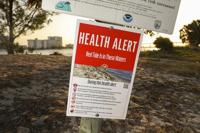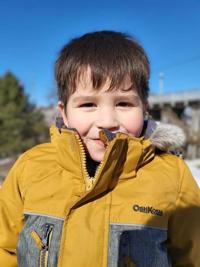TALLAHASSEE, Fla. (AP) — Residents of Florida’s Gulf Coast who weathered back-to-back hurricanes now have something else to keep an eye on -– a possible plume of harmful algae in the waters off the state’s southwest coast.
shows a bloom of algae extending along Florida's western coastline near Tampa, though researchers caution that Hurricanes Helene and Milton have delayed regular sampling to confirm the findings. Federal officials say there is currently “no risk of respiratory irritation” from red tide in Florida.
occur when algae — plant-like organisms that live in salt and freshwater — grow out of control and produce harmful toxins that can and sicken people and pets.
“It’s so dense that it actually discolors the water, right? Hence the red tide name,” said Beth Stauffer, a professor of biology at the University of Louisiana at Lafayette.
According to researchers, the main species responsible for the blooms along Florida’s Gulf Coast is Karenia brevis, a single-celled organism that produces a potent neurotoxin that can be suspended in the air near beaches and make people sick when they breathe it in.
“(It) not only impacts some of the fish and manatees and some of the other marine mammals, but can impact human health through the toxin being aerosolized and hurting folks who have respiratory or autoimmune issues,” Stauffer said.
Scientists say Florida’s back-to-back hits from Hurricanes Helene and Milton could be fueling the growth of toxic algae that was already present before the storms slammed the coast.
Here’s what to know about red tide — and how hurricanes could affect it.
What is red tide?
Red tides, which scientists refer to as harmful algae blooms, occur when aquatic microorganisms grow out of control, producing toxins that can kill fish, make shellfish unsafe to eat and leave the air difficult to breathe.
Many different kinds of microorganisms cause toxic blooms in fresh and saltwater around the world, but researchers say the culprit behind southwest Florida’s cyclical blooms is a species known as Karenia brevis.
Florida typically sees red tide off the state’s southwest coast every year in late summer or early fall when warmer temperatures and wind conditions are more favorable to algae growth.
Hurricanes don’t cause red tide – but they can make it worse
Experts say there are a lot of factors that can influence a harmful algae bloom, from the availability of nutrients to wind conditions to the powerful underwater currents that help power the ocean’s food chains.
While the researchers who spoke with The Associated Press didn’t agree on whether hurricanes can disrupt a harmful algae bloom, they did say that these powerful storms can by churning up nutrient-rich water that fuels the growth of the microorganisms.
“Hurricanes do bring up deeper water in the Gulf of Mexico, which has more nutrients. They also could produce a lot of rain. You have runoff from the land, which also adds nutrients,” said Richard Stumpf, an oceanographer with the ������ϲʹ������� Oceanic and Atmospheric Administration. “It tends to intensify a bloom that’s already there."
Hurricanes can also steer blooms ashore, even pushing them hundreds of miles up the coast, according to Stumpf.
“We saw an extreme case with Katrina, which of course didn’t really affect Florida, but it was such a big storm, it actually took a bloom that was off southwest Florida and put it on the Panhandle,” he said.
What are the health concerns?
Harmful algae blooms can pose a deadly threat to aquatic animals, with some causing massive die-offs that choke beaches with rotting fish. People who breathe in the toxins may experience like coughing, shortness of breath or dizziness.
“It’s like an instant cold. Go down to the beach, start coughing just as you cross over the dune and then eyes start watering and nose running,” Stumpf said.
“Once I leave and 10 minutes later, I'm fine," he said. “It's so odd.”
Those with asthma or other respiratory issues may experience more serious health effects or even need medical attention. Some pets that have come into contact with harmful algae have become seriously ill or even died.
What are conditions like now?
According to a red tide monitoring maintained by the Florida Fish and Wildlife Conservation Commission, medium and high levels of Karenia brevis concentrations were detected in some coastal locations near Pinellas County, home to St. Petersburg, between Sept. 26 and Oct. 3 – just as Hurricane Helene crashed ashore in the Big Bend region and in the week that followed.
A NOAA shows there is currently “no risk of respiratory irritation” from red tide algae in Florida.
Researchers say that some efforts to gather and analyze data have been delayed due to the storms.
“It looks like the hurricane actually helped facilitate what is an evolving red tide bloom along the coastline,” said Robert Weisberg, an emeritus professor of physical oceanography at the University of South Florida. “The caveat is we have not gone out to sample it yet so we don’t know exactly what’s out there.”
___ Kate Payne is a corps member for The Associated Press/Report for America Statehouse News Initiative. is a nonprofit national service program that places journalists in local newsrooms to report on undercovered issues.








































